Effect of Iron-Doping on the Structure and Photocatalytic Activity of TiO2 Nanoparticles
Abstract
1. Introduction
2. Results and Discussion
2.1. Fourier-Transform Infrared Spectroscopy (FTIR)
2.2. X-ray Diffraction (XRD)
2.3. Scanning Electron Microscopy (SEM) and Energy Dispersive Spectroscopy (EDS)
2.4. Diffuse Reflectance Spectroscopy (DRS)
2.5. Evaluation of the Photocatalytic Activity of the Doped Material
3. Materials and Methods
3.1. Diffuse Reflectance Spectroscopy (DRS) and Kubelka–Munk Transform
3.2. X-ray Diffraction (XRD)
3.3. Fourier-Transform Infrared Spectroscopy (FTIR)
3.4. Scanning Electron Microscopy (SEM) and Energy Dispersive Spectroscopy (EDS)
3.5. Photocatalytic Activity
4. Conclusions
- The process of doping TiO2 with FeCl3 provided changes in the optical properties of the material and a decrease in the Eg of TiO2, also after the calcination process. The doping concentrations that presented the lowest Eg values were (1:1), (1:1.6), and (1:3).
- Contrarily to the effect after calcination, in the doping process the nanoparticles have no significant influence on the anatase-to-rutile transformation (ART) compared to the reference TiO2.
- The Fe-doping process modified the reference TiO2 spectrum with higher intensity of hydroxyl bonds and vibration of the Ti–O–Fe bond. After the calcination process, a drastic reduction of these bonds occurred.
- The particles are within the nanometer scale, and there are indications of the chemical reaction between TiO2 and Fe. The calcination process causes a relevant increase in particle size and surface smoothing.
- The ratio (1:1.6) of TiO2:FeCl3 showed the highest activity in the photocatalytic degradation of RhB with an efficiency of 93.8% after 3 h of irradiation.
Author Contributions
Funding
Data Availability Statement
Conflicts of Interest
References
- Rocha Segundo, I.; Freitas, E.; Branco, V.T.F.C.; Landi, S.; Costa, M.F.; Carneiro, J.O. Review and analysis of advances in functionalized, smart, and multifunctional asphalt mixtures. Renew. Sustain. Energy Rev. 2021, 151, 111552. [Google Scholar] [CrossRef]
- Zabihi-Mobarakeh, H.; Nezamzadeh-Ejhieh, A. Application of supported TiO2 onto Iranian clinoptilolite nanoparticles in the photodegradation of mixture of aniline and 2,4-dinitroaniline aqueous solution. J. Ind. Eng. Chem. 2015, 26, 315–321. [Google Scholar] [CrossRef]
- Nezamzadeh-Ejhieh, A.; Bahrami, M. Investigation of the photocatalytic activity of supported ZnO–TiO2 on clinoptilolite nano-particles towards photodegradation of wastewater-contained phenol. Desalin. Water Treat. 2015, 55, 1096–1104. [Google Scholar] [CrossRef]
- Rocha Segundo, I.; Freitas, E.; Landi, S., Jr.; Costa, M.F.M.; Carneiro, J.O. Smart, Photocatalytic and Self-Cleaning Asphalt Mixtures: A Literature Review. Coatings 2019, 9, 696. [Google Scholar] [CrossRef]
- Carneiro, J.O.; Azevedo, S.; Fernandes, F.; Freitas, E.; Pereira, M.; Tavares, C.J.; Lanceros-Méndez, S.; Teixeira, V. Synthesis of iron-doped TiO2 nanoparticles by ball-milling process: The influence of process parameters on the structural, optical, magnetic, and photocatalytic properties. J. Mater. Sci. 2014, 49, 7476–7488. [Google Scholar] [CrossRef]
- Ghorbanpour, M.; Feizi, A. Iron-doped TiO2 Catalysts with Photocatalytic Activity. J. Water Environ. Nanotechnol. 2019, 4, 60–66. [Google Scholar] [CrossRef]
- Zahabizadeh, B.; Segundo, I.R.; Pereira, J.; Freitas, E.; Camões, A.; Tavares, C.J.; Teixeira, V.; Cunha, V.M.C.F.; Costa, M.F.M.; Carneiro, J.O. Development of Photocatalytic 3D-Printed Cementitious Mortars: Influence of the Curing, Spraying Time Gaps and TiO2 Coating Rates. Buildings 2021, 11, 381. [Google Scholar] [CrossRef]
- Adamek, E.; Baran, W.; Ziemiańska, Justyna Makowski, A.; Sobczak, A. Use of a TiO2/FeCl3 mixture in environmental cleaning technology. Proc. ECOpole 2012, 6. [Google Scholar] [CrossRef]
- Wang, J.; Wang, Z.; Zhao, D.; Liang, Y.; Wang, H.; Wang, N.; Jiang, W.; Liu, S.; Liu, C.; Ding, W.; et al. Preparation, structural and photocatalytic activity of Sn/Fe co-doped TiO2 nanoparticles by sol-gel method. Ceram. Int. 2022, 48, 8297–8305. [Google Scholar] [CrossRef]
- Lucas, S.S.; Ferreira, V.M.; de Aguiar, J.L.B. Incorporation of titanium dioxide nanoparticles in mortars—Influence of microstructure in the hardened state properties and photocatalytic activity. Cem. Concr. Res. 2013, 43, 112–120. [Google Scholar] [CrossRef]
- Di Valentin, C.; Finazzi, E.; Pacchioni, G.; Selloni, A.; Livraghi, S.; Paganini, M.C.; Giamello, E. N-doped TiO2: Theory and experiment. Chem. Phys. 2007, 339, 44–56. [Google Scholar] [CrossRef]
- Alkorbi, A.S.; Muhammad Asif Javed, H.; Hussain, S.; Latif, S.; Mahr, M.S.; Mustafa, M.S.; Alsaiari, R.; Alhemiary, N.A. Solar light-driven photocatalytic degradation of methyl blue by carbon-doped TiO2 nanoparticles. Opt. Mater. 2022, 127, 112259. [Google Scholar] [CrossRef]
- Barakat, M.A.; Schaeffer, H.; Hayes, G.; Ismat-Shah, S. Photocatalytic degradation of 2-chlorophenol by Co-doped TiO2 nanoparticles. Appl. Catal. B Environ. 2005, 57, 23–30. [Google Scholar] [CrossRef]
- Cao, X.; Yang, X.; Li, H.; Huang, W.; Liu, X. Investigation of Ce-TiO2 photocatalyst and its application in asphalt-based specimens for NO degradation. Constr. Build. Mater. 2017, 148, 824–832. [Google Scholar] [CrossRef]
- Etacheri, V.; Di Valentin, C.; Schneider, J.; Bahnemann, D.; Pillai, S.C. Visible-light activation of TiO2 photocatalysts: Advances in theory and experiments. J. Photochem. Photobiol. C Photochem. Rev. 2015, 25, 1–29. [Google Scholar] [CrossRef]
- Eadi, S.B.; Kim, S.; Jeong, S.W.; Jeon, H.W. Novel Preparation of Fe Doped TiO2 Nanoparticles and Their Application for Gas Sensor and Photocatalytic Degradation. Adv. Mater. Sci. Eng. 2017, 2017, 2191659. [Google Scholar] [CrossRef]
- Zaleska, A. Doped-TiO2: A Review. Recent Patents Eng. 2008, 2, 157–164. [Google Scholar] [CrossRef]
- Ganesh, I.; Kumar, P.; Gupta, A.; Sekhar, P.; Radha, K.; Padmanabham, G.; Sundararajan, G. Preparation and characterization of Fe-doped TiO2 powders for solar light response and photocatalytic applications. Process. Appl. Ceram. 2012, 6, 21–36. [Google Scholar] [CrossRef]
- Piątkowska, A.; Janus, M.; Szymański, K.; Mozia, S. C-,N- and S-Doped TiO2 Photocatalysts: A Review. Catalysts 2021, 11, 144. [Google Scholar] [CrossRef]
- Landi, S.; Carneiro, J.; Soares, O.S.G.P.; Pereira, M.F.R.; Gomes, A.C.; Ribeiro, A.; Fonseca, A.M.; Parpot, P.; Neves, I.C. Photocatalytic performance of N-doped TiO2nano-SiO2-HY nanocomposites immobilized over cotton fabrics. J. Mater. Res. Technol. 2019, 8, 1933–1943. [Google Scholar] [CrossRef]
- Liu, C.; Mao, S.; Shi, M.; Wang, F.; Xia, M.; Chen, Q.; Ju, X. Peroxymonosulfate activation through 2D/2D Z-scheme CoAl-LDH/BiOBr photocatalyst under visible light for ciprofloxacin degradation. J. Hazard. Mater. 2021, 420, 126613. [Google Scholar] [CrossRef] [PubMed]
- Liu, C.; Mao, S.; Shi, M.; Hong, X.; Wang, D.; Wang, F.; Xia, M.; Chen, Q. Enhanced photocatalytic degradation performance of BiVO4/BiOBr through combining Fermi level alteration and oxygen defect engineering. Chem. Eng. J. 2022, 449, 137757. [Google Scholar] [CrossRef]
- Venturini, L.; Bacchi, I. Research, Design and Development of a Photocatalytic Asphalt Pavement. In Proceedings of the 2nd International Conference on Environmentally Friendly Roads, ENVIROAD 2009, Warsaw, Poland, 15–16 October 2009; pp. 1–16. [Google Scholar]
- Cano-Casanova, L.; Ansón-Casaos, A.; Hernández-Ferrer, J.; Benito, A.M.; Maser, W.K.; Garro, N.; Lillo-Ródenas, M.A.; Román-Martínez, M.C. Surface-Enriched Boron-Doped TiO2 Nanoparticles as Photocatalysts for Propene Oxidation. ACS Appl. Nano Mater. 2022, 5, 12527–12539. [Google Scholar] [CrossRef] [PubMed]
- Cano-Casanova, L.; Amorós-Pérez, A.; Ouzzine, M.; Lillo-Ródenas, M.A.; Román-Martínez, M.C. One step hydrothermal synthesis of TiO2 with variable HCl concentration: Detailed characterization and photocatalytic activity in propene oxidation. Appl. Catal. B Environ. 2018, 220, 645–653. [Google Scholar] [CrossRef]
- Qin, Q.; Wang, J.; Xia, Y.; Yang, D.; Zhou, Q.; Zhu, X.; Feng, W. Synthesis and Characterization of Sn/Ni Single Doped and Co–Doped Anatase/Rutile Mixed–Crystal Nanomaterials and Their Photocatalytic Performance under UV–Visible Light. Catalysts 2021, 11, 1341. [Google Scholar] [CrossRef]
- Fan, W.; Chan, K.Y.; Zhang, C.; Zhang, K.; Ning, Z.; Leung, M.K.H. Solar photocatalytic asphalt for removal of vehicular NOx: A feasibility study. Appl. Energy 2018, 225, 535–541. [Google Scholar] [CrossRef]
- Tang, B.; Liu, X.; Huang, W.; Cao, X. Preparation of La-doped nanometer TiO2 and its application for NO removal on asphalt concrete. Road Mater. Pavement Des. 2017, 18, 43–53. [Google Scholar] [CrossRef]
- Yeganeh, M.; Shahtahmasebi, N.; Kompany, A.; Karimipour, M.; Razavi, F.; Nasralla, N.H.S.; Šiller, L. The magnetic characterization of Fe doped TiO2 semiconducting oxide nanoparticles synthesized by sol–gel method. Phys. B Condens. Matter 2017, 511, 89–98. [Google Scholar] [CrossRef][Green Version]
- Ali, T.; Tripathi, P.; Azam, A.; Raza, W.; Ahmed, A.S.; Ahmed, A.; Muneer, M. Photocatalytic performance of Fe-doped TiO2 nanoparticles under visible-light irradiation. Mater. Res. Express 2017, 4, 015022. [Google Scholar] [CrossRef]
- Sood, S.; Umar, A.; Mehta, S.K.; Kansal, S.K. Highly effective Fe-doped TiO2 nanoparticles photocatalysts for visible-light driven photocatalytic degradation of toxic organic compounds. J. Colloid Interface Sci. 2015, 450, 213–223. [Google Scholar] [CrossRef]
- Xiang, L.; Zhao, X. Wet-Chemical Preparation of TiO2-Based Composites with Different Morphologies and Photocatalytic Properties. Nanomaterials 2017, 7, 310. [Google Scholar] [CrossRef] [PubMed]
- Kutuzova, A.; Dontsova, T. Synthesis, characterization and properties of titanium dioxide obtained by hydrolytic method. In Proceedings of the 2017 IEEE 7th International Conference Nanomaterials: Application & Properties (NAP), Odessa, Ukraine, 10–15 September 2017; IEEE: Hoboken, NJ, USA, 2017; pp. 01NNPT02-1–01NNPT02-5. [Google Scholar]
- Homem, N.C.; Yamaguchi, N.U.; Vieira, M.F.; Amorim, M.T.S.P.; Bergamasco, R. Surface modification of microfiltration membrane with GO nanosheets for dyes removal from aqueous solutions. Chem. Eng. Trans. 2017, 60, 259–264. [Google Scholar] [CrossRef]
- Ribao, P.; Corredor, J.; Rivero, M.J.; Ortiz, I. Role of reactive oxygen species on the activity of noble metal-doped TiO2 photocatalysts. J. Hazard. Mater. 2019, 372, 45–51. [Google Scholar] [CrossRef] [PubMed]
- Shahmoradi, B.; Maleki, A.; Byrappa, K. Removal of Disperse Orange 25 using in situ surface-modified iron-doped TiO2 nanoparticles. Desalin. Water Treat. 2015, 53, 3615–3622. [Google Scholar] [CrossRef]
- Marami, M.B.; Farahmandjou, M.; Khoshnevisan, B. Sol–Gel Synthesis of Fe-Doped TiO2 Nanocrystals. J. Electron. Mater. 2018, 47, 3741–3748. [Google Scholar] [CrossRef]
- Tonejc, A..; Djerdj, I.; Tonejc, A. An analysis of evolution of grain size-lattice parameters dependence in nanocrystalline TiO2 anatase. Mater. Sci. Eng. C 2002, 19, 85–89. [Google Scholar] [CrossRef]
- Kim, W.; Tachikawa, T.; Moon, G.; Majima, T.; Choi, W. Molecular-Level Understanding of the Photocatalytic Activity Difference between Anatase and Rutile Nanoparticles. Angew. Chemie Int. Ed. 2014, 53, 14036–14041. [Google Scholar] [CrossRef]
- Valencia, S.; Marin, J.M.; Restrepo, G. Study of the Bandgap of Synthesized Titanium Dioxide Nanoparticules Using the Sol-Gel Method and a Hydrothermal Treatment. Open Mater. Sci. J. 2010, 4, 9–14. [Google Scholar] [CrossRef]
- Landi, S.; Segundo, I.R.; Freitas, E.; Vasilevskiy, M.; Carneiro, J.; Tavares, C.J. Use and misuse of the Kubelka-Munk function to obtain the band gap energy from diffuse reflectance measurements. Solid State Commun. 2022, 341, 114573. [Google Scholar] [CrossRef]
- Landi, S.; Segundo, I.R.; Afonso, C.; Lima, O.; Costa, M.F.M.; Freitas, E.; Carneiro, J. Evaluation of band gap energy of TiO2 precipitated from titanium sulphate. Phys. B Condens. Matter 2022, 639, 414008. [Google Scholar] [CrossRef]
- Jenkins, R.; Snyder, R. Introduction to X-ray Powder Diffractometry; Wiley-Interscience: New York, NY, USA, 1996; ISBN 978-0-471-51339-1. [Google Scholar]
- Spurr, R.A.; Myers, H. Quantitative Analysis of Anatase-Rutile Mixtures with an X-Ray Diffractometer. Anal. Chem. 1957, 29, 760–762. [Google Scholar] [CrossRef]
- Rocha Segundo, I.; Ferreira, C.; Freitas, E.F.; Carneiro, J.O.; Fernandes, F.; Júnior, S.L.; Costa, M.F.; Landi Júnior, S.; Costa, M.F. Assessment of photocatalytic, superhydrophobic and self-cleaning properties on hot mix asphalts coated with TiO2 and/or ZnO aqueous solutions. Constr. Build. Mater. 2018, 166, 36–44. [Google Scholar] [CrossRef]
- Yang, X.; Cao, C.; Erickson, L.; Hohn, K.; Maghirang, R.; Klabunde, K. Photo-catalytic degradation of Rhodamine B on C-, S-, N-, and Fe-doped TiO2 under visible-light irradiation. Appl. Catal. B Environ. 2009, 91, 657–662. [Google Scholar] [CrossRef]
- Barkhade, T.; Banerjee, I. Photocatalytic degradation of Rhodamine B dye using Fe doped TiO2 nanocomposites. AIP Conf. Proc. 2018, 1961, 030016. [Google Scholar]
- Carneiro, J.O.; Azevedo, S.; Teixeira, V.; Fernandes, F.; Freitas, E.; Silva, H.; Oliveira, J. Development of photocatalytic asphalt mixtures by the deposition and volumetric incorporation of TiO2 nanoparticles. Constr. Build. Mater. 2013, 38, 594–601. [Google Scholar] [CrossRef]
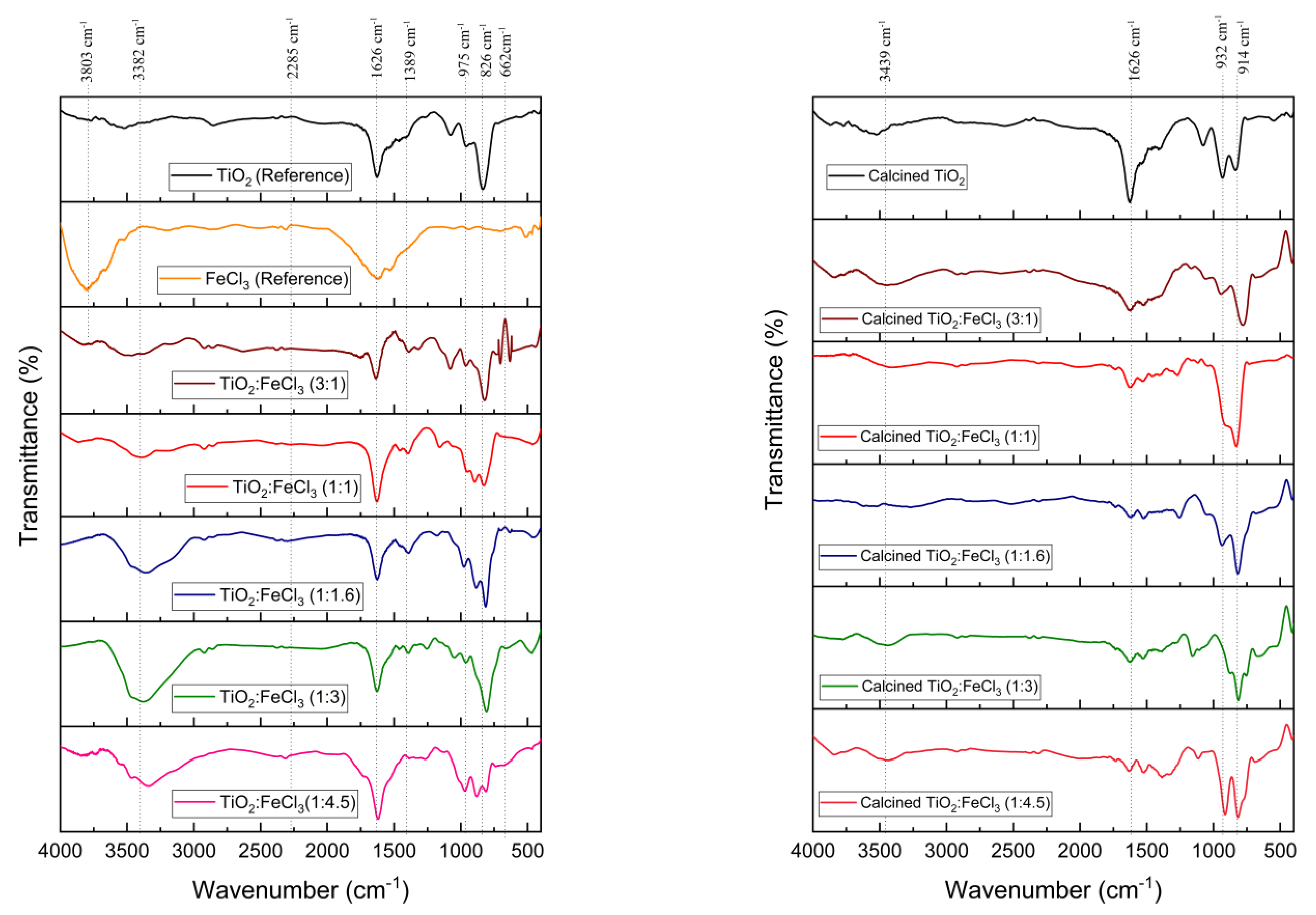
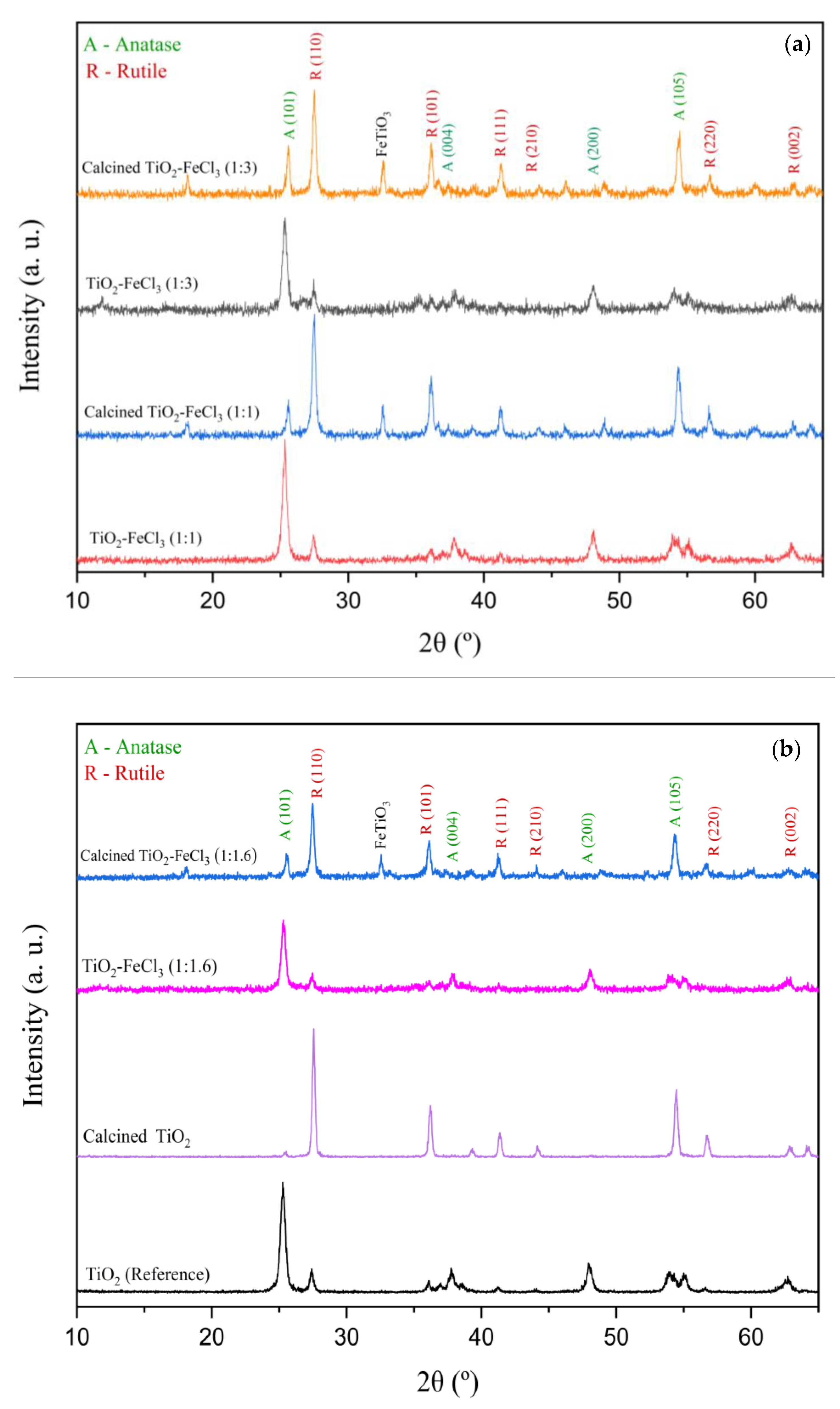

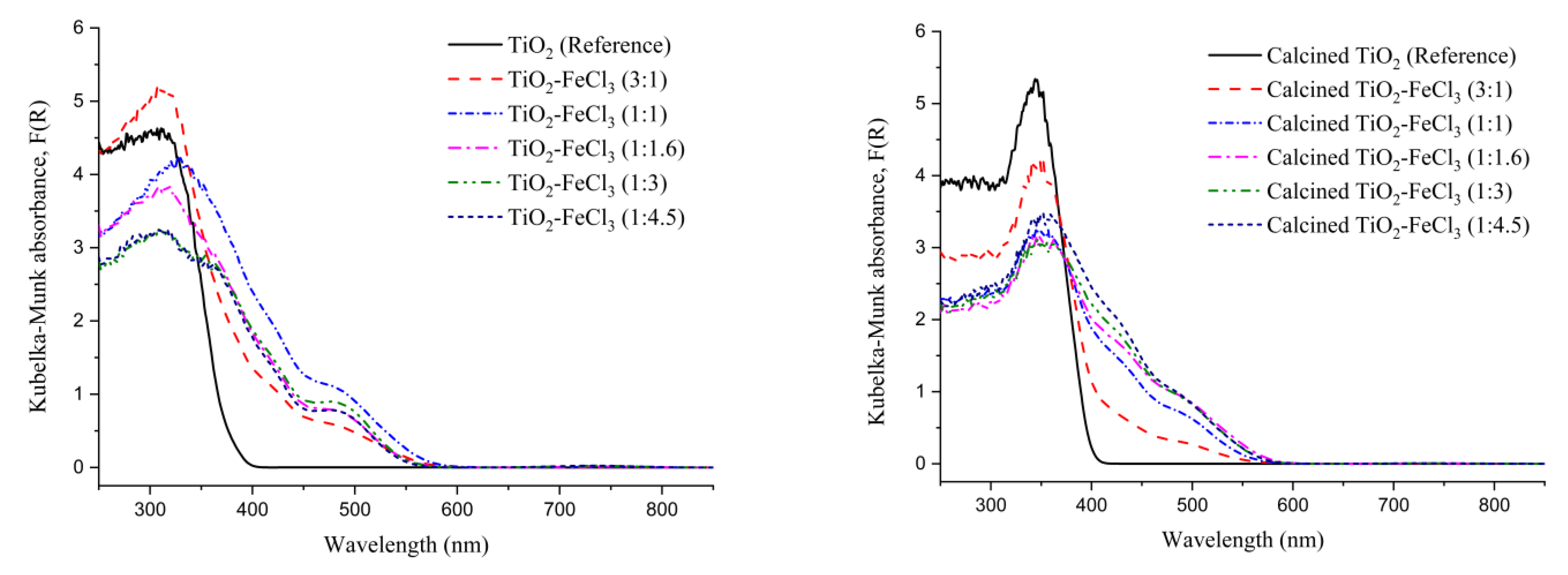
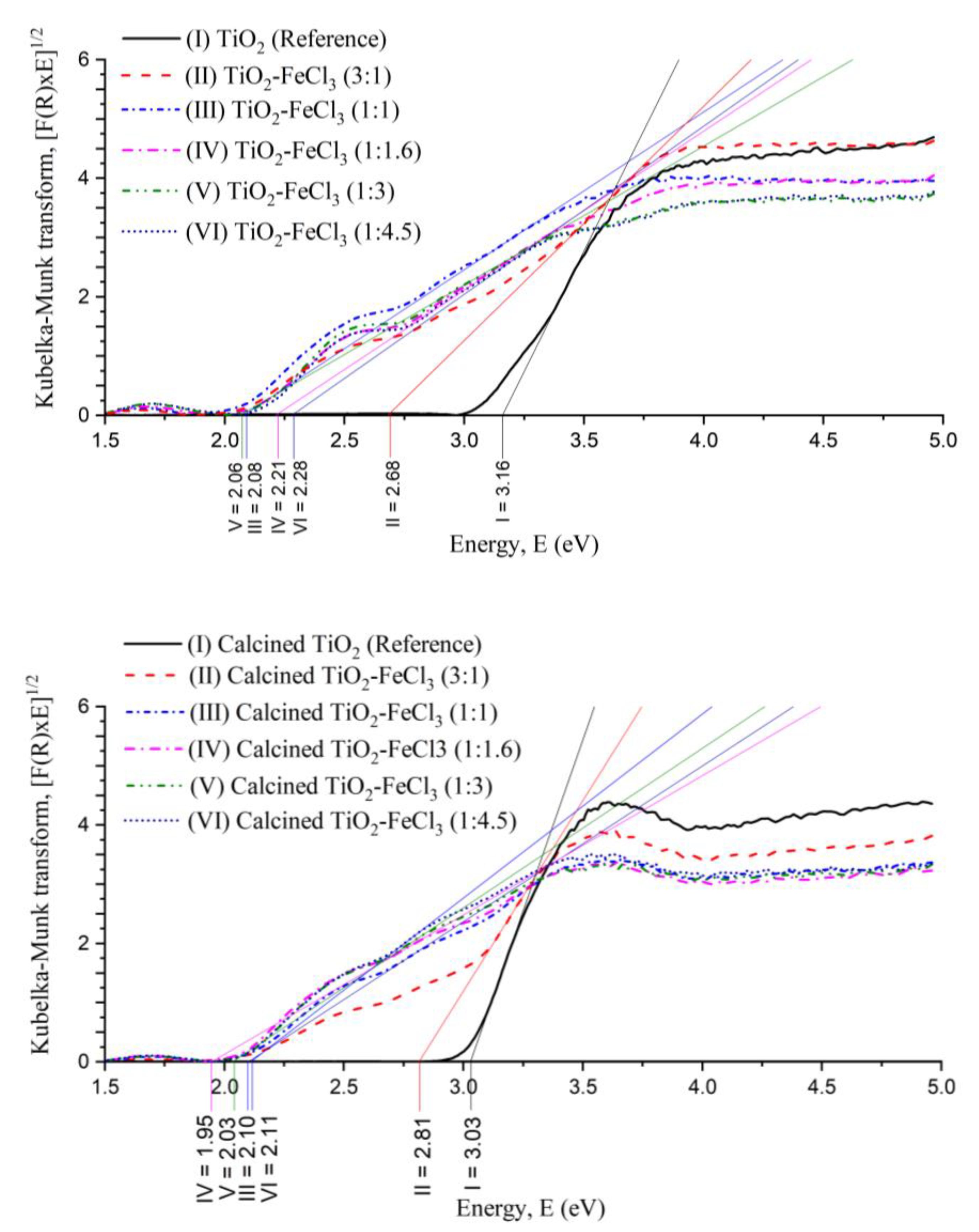
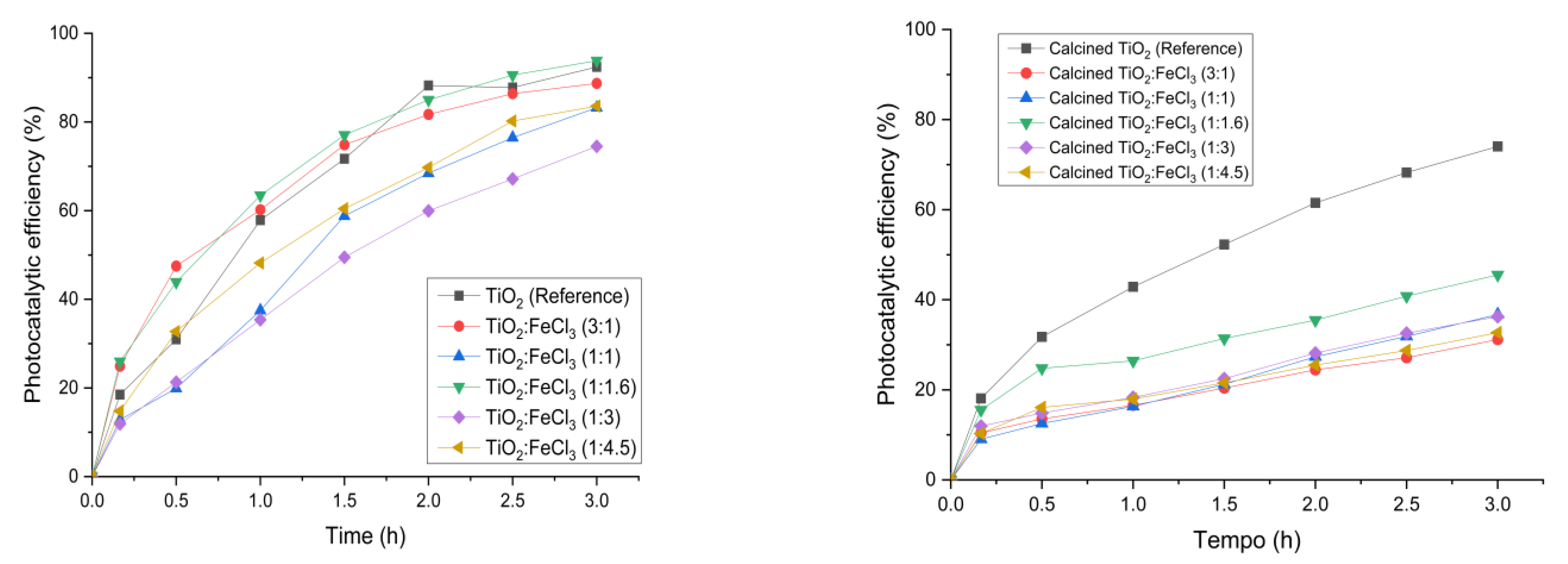
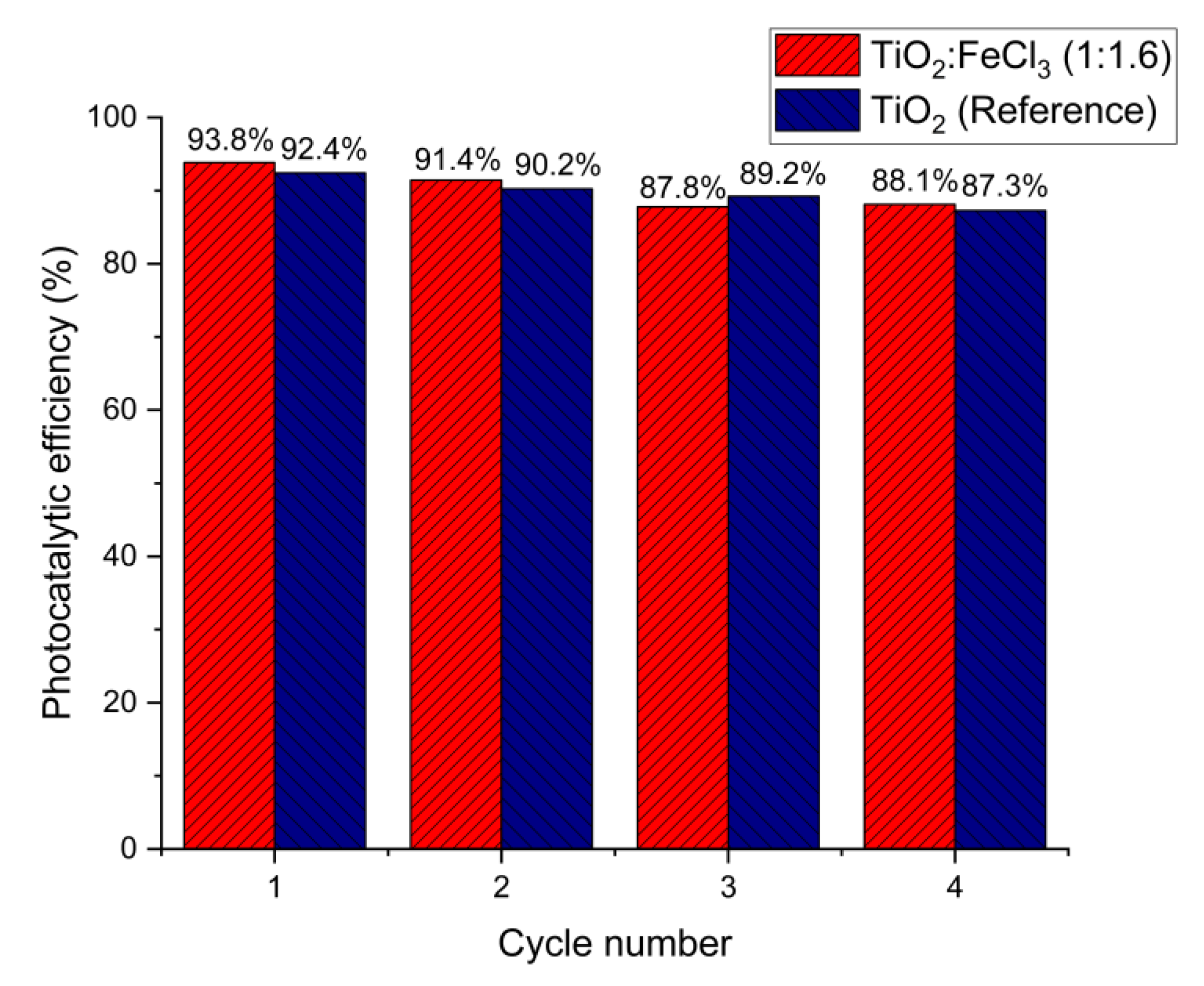

| Composition | Crystallite Size (nm) | Lattice Parameters (Å) | Unit Cell Volume (Å3) | XA (%) | |||||
|---|---|---|---|---|---|---|---|---|---|
| Anatase | Rutile | Anatase | Rutile | Anatase | Rutile | ||||
| a | c | a | c | ||||||
| TiO2 (reference) | 18.4879 | 29.7536 | 3.7907 | 9.5154 | 4.5946 | 2.9613 | 136.7307 | 62.5141 | 80.82 |
| Calcined TiO2 | 18.5277 | 32.2752 | 3.7531 | 9.4134 | 4.5717 | 2.9288 | 132.5949 | 61.2132 | 37.31 |
| TiO2-FeCl3 (1:1) | 19.4046 | 22.0470 | 3.7832 | 9.4710 | 4.5913 | 2.9605 | 135.5547 | 62.4074 | 87.95 |
| Calcined TiO2-FeCl3 (1:1) | 28.1559 | 26.3592 | 3.7523 | 9.4259 | 4.5814 | 2.9558 | 132.7144 | 62.0399 | 37.16 |
| TiO2-FeCl3 (1:1.6) | 19.8477 | 22.6825 | 3.7833 | 9.7596 | 4.5847 | 2.9595 | 139.6927 | 62.2071 | 92.90 |
| Calcined TiO2-FeCl3 (1:1.6) | 28.8106 | 27.4820 | 3.7447 | 9.4408 | 4.5864 | 2.9557 | 132.3862 | 62.1733 | 42.30 |
| TiO2-FeCl3 (1:3) | 19.6765 | 25.7432 | 3.7855 | 9.3839 | 4.5913 | 2.9644 | 132.5812 | 62.4897 | 60.27 |
| Calcined TiO2-FeCl3 (1:3) | 29.9340 | 27.0145 | 3.7424 | 9.4242 | 4.5814 | 2.9558 | 131.9912 | 62.0399 | 41.69 |
| Samples | Particle Size (nm) | Chemical Composition (%) | |||
|---|---|---|---|---|---|
| Ti * | O * | Fe * | Cl * | ||
| TiO2 (reference) | 20–30 | 65.49 | 34.51 | - | - |
| Calcined TiO2 | 50–108 | 66.79 | 33.21 | - | - |
| TiO2-FeCl3 (1:1.6) | 23–27 | 44.98 | 39.14 | 14.02 | 1.85 |
| Calcined TiO2-FeCl3 (1:1.6) | 49–51 | 50.69 | 35.31 | 14.00 | - |
| TiO2-FeCl3 (1:3) | 27–38 | 37.80 | 41.77 | 17.95 | 2.48 |
Disclaimer/Publisher’s Note: The statements, opinions and data contained in all publications are solely those of the individual author(s) and contributor(s) and not of MDPI and/or the editor(s). MDPI and/or the editor(s) disclaim responsibility for any injury to people or property resulting from any ideas, methods, instructions or products referred to in the content. |
© 2022 by the authors. Licensee MDPI, Basel, Switzerland. This article is an open access article distributed under the terms and conditions of the Creative Commons Attribution (CC BY) license (https://creativecommons.org/licenses/by/4.0/).
Share and Cite
Afonso, C.; Lima, O., Jr.; Segundo, I.R.; Landi, S., Jr.; Margalho, É.; Homem, N.; Pereira, M.; Costa, M.F.M.; Freitas, E.; Carneiro, J. Effect of Iron-Doping on the Structure and Photocatalytic Activity of TiO2 Nanoparticles. Catalysts 2023, 13, 58. https://doi.org/10.3390/catal13010058
Afonso C, Lima O Jr., Segundo IR, Landi S Jr., Margalho É, Homem N, Pereira M, Costa MFM, Freitas E, Carneiro J. Effect of Iron-Doping on the Structure and Photocatalytic Activity of TiO2 Nanoparticles. Catalysts. 2023; 13(1):58. https://doi.org/10.3390/catal13010058
Chicago/Turabian StyleAfonso, Cátia, Orlando Lima, Jr., Iran Rocha Segundo, Salmon Landi, Jr., Élida Margalho, Natália Homem, Mário Pereira, Manuel F. M. Costa, Elisabete Freitas, and Joaquim Carneiro. 2023. "Effect of Iron-Doping on the Structure and Photocatalytic Activity of TiO2 Nanoparticles" Catalysts 13, no. 1: 58. https://doi.org/10.3390/catal13010058
APA StyleAfonso, C., Lima, O., Jr., Segundo, I. R., Landi, S., Jr., Margalho, É., Homem, N., Pereira, M., Costa, M. F. M., Freitas, E., & Carneiro, J. (2023). Effect of Iron-Doping on the Structure and Photocatalytic Activity of TiO2 Nanoparticles. Catalysts, 13(1), 58. https://doi.org/10.3390/catal13010058













